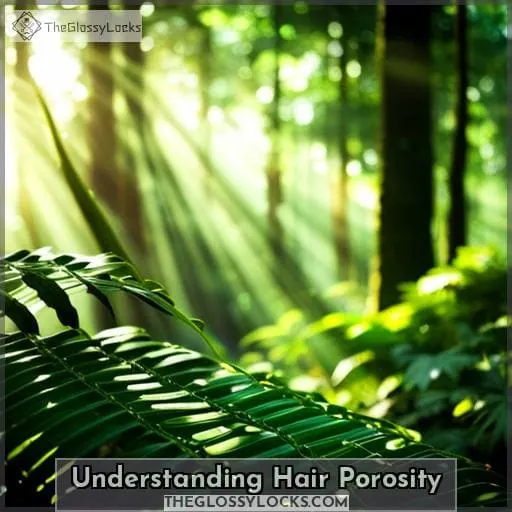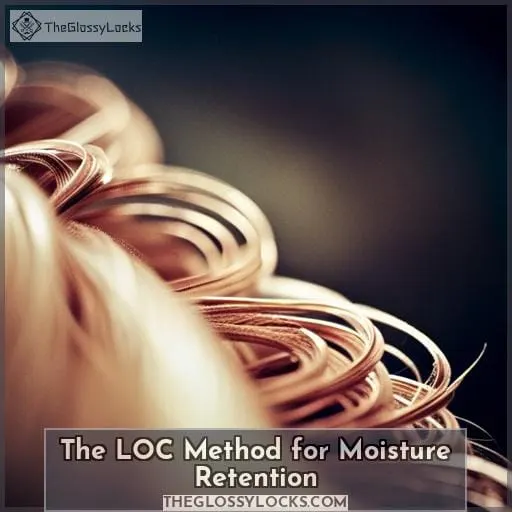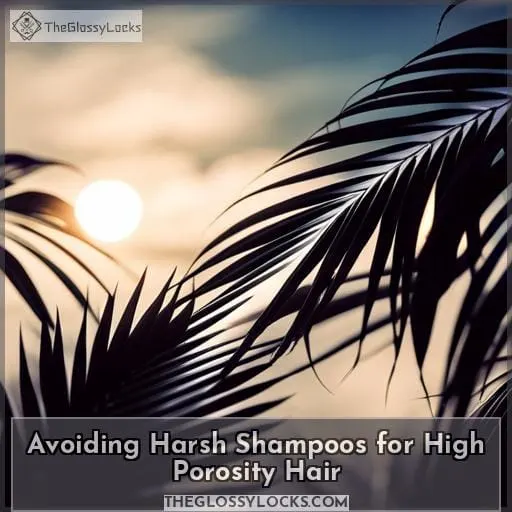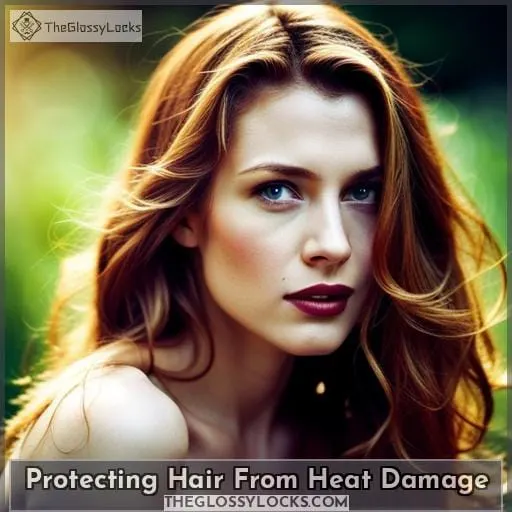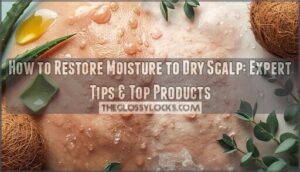This site is supported by our readers. We may earn a commission, at no cost to you, if you purchase through links.

High porosity hair is defined as having an open cuticle layer which allows for easy absorption of water or moisture. However, it also makes locking in that same moisture difficult. The causes of this type of texture vary from genetics to over-manipulation.
This article provides insight into how best to tackle growing and retaining hydration in high porosity tresses, so read on!
Table Of Contents
- Key Takeaways
- Understanding Hair Porosity
- Causes of High Porosity Hair
- Tips for Growing High Porosity Hair
- The Importance of Deep Conditioning
- The LOC Method for Moisture Retention
- Benefits of Protein Treatments for High Porosity Hair
- The Use of Apple Cider Vinegar for Hair Health
- Avoiding Harsh Shampoos for High Porosity Hair
- Protecting Hair From Heat Damage
- Gentle Detangling and Protective Hairstyles for High Porosity Hair
- Conclusion
Key Takeaways
- Hair porosity levels can be low, normal, or high, and the effectiveness of hair products varies based on porosity.
- High porosity hair can be caused by over-manipulation, chemical treatments, genetics, aging, and damage.
- Proper hair care and maintenance for high porosity hair includes using sulfate-free products, light oils like coconut and marula, protein treatments, and a balanced diet with vitamins and nutrients.
- Protective measures such as using heat protectants, gentle detangling with a wide-tooth comb, and opting for protective hairstyles like braids and wigs can help promote the growth of high porosity hair.
Understanding Hair Porosity
You need to understand your hair porosity level so you can tailor a care routine that helps retain moisture and reduce breakage. Hair porosity is the ability of your strands to absorb and hold onto water, oils, or other substances.
Low porosity hair tends to be more tightly packed with cuticles that don’t easily open up for hydration. High-porosity locks often struggle with maintaining moisture but take in product quickly due to their wide-open cuticles.
Misconceptions about these levels should be taken into account when determining which products will work best for you.
When it comes down to growing out high-porosity tresses specifically, diet plays an important role in healthy growth by providing essential nutrients for strong strands. Using natural sulfate-free shampoos, as well as restorative conditioners, also go a long way towards protecting the integrity of fragile hairs since they tend to damage more easily than others do.
Applying light oils like coconut oil or marula oil helps seal the edges from external factors such as windy days or dry air without weighing them down too much.
Lastly, adding protein treatments every few weeks fortifies weak spots along shafts, giving greater flexibility against daily styling habits.
Causes of High Porosity Hair
Are you wondering what causes high porosity hair? Over manipulation, chemicals and heat, genetics and aging, as well as damage and over-processing can all contribute to this type of hair. It’s important to understand the key factors so that you can better care for your own high porosity locks.
Over Manipulation
Too much styling and tugging can cause your mane to become high porosity, so maybe it’s time you gave your hair a break! To prevent breakage, opt for protective hairstyles like braids or buns. Moisture retention is key too; use conditioning treatments regularly and detangle gently with wide-tooth combs.
Chemicals and Heat
Excessive chemical processing and heat can damage hair, leading to high porosity. Protect your locks with a heat protectant when styling and avoid harsh chemicals. For healthy growth, use sulfate-free products and select those specifically for porous strands.
Balance moisture by sealing in hydration after each wash, then cut down on product buildup with light formulas designed for low porosity hair types.
Genetics and Aging
Have you ever wondered if genetics and aging could be the cause of your high porosity hair? High porosity can result from a combination of genetic predisposition, age-related damage, and environmental factors.
Hair health is key to growing strong strands; deep conditioning with restorative formulas helps repair damaged cuticles while coconut oil seals in moisture.
Damage and Over-processing
Damage from over-processing and styling can be detrimental to your hair’s porosity level. To prevent breakage, use heat protection when styling, choose chemical treatments wisely, and limit their frequency of use.
Repairing damage requires regular trims, as well as avoiding harsh shampoos that strip the hair of its natural oils. For healthy, high porosity hair growth, maintain a consistent yet gentle routine based on your individual needs.
Tips for Growing High Porosity Hair
Growing high porosity hair requires a combination of diet, nutrition, and consistent care. Eating a balanced diet full of nutrients such as proteins and vitamins can help support healthy hair growth while avoiding crash diets.
Also, make sure to use natural sulfate-free products that are designed specifically for high porosity hair; these will help keep your strands hydrated and minimize damage from over manipulation or heat styling tools.
Finally, seal in moisture with oils like coconut oil or aloe vera gel to ensure the longevity of each style.
Diet and Nutrition
A balanced diet is essential for healthy hair growth, so make sure you’re getting enough vitamins and minerals. Studies show that up to 88% of women aren’t meeting their daily nutrient needs. Eating foods rich in vitamins A, C, and E will increase hydration levels, which are key for high porosity hair.
Avoid crash diets, as they can cause dryness. Instead, focus on protein-rich meals that contain biotin, omega 3 fatty acids, and iron – all of which are beneficial for strong, growing locks.
To ensure you’re getting the right nutrients for an amazing mane, follow these simple tips: eat a variety of fruits and veggies, drink plenty of water, and avoid unhealthy snacks.
Follow this advice, and watch your high porosity hair flourish!
Hair Care Routine
To maintain healthy hair, it’s important to create a tailored hair care routine that caters to your high porosity level. Deep condition every two weeks with nourishing formulas and use the LOC method for moisture-locking techniques.
Avoid tight hairstyles and opt for protective styling tips instead. Try using aloe vera gel as a sealant after shampooing, install a shower filter for better water quality when washing, and finger detangle regularly to prevent matting or breakage of fragile strands.
Hair Washing and Styling
Take care when washing your hair to avoid breakage and keep it looking its best. Shorten showers, minimize washing, and opt for low-tension hairstyles to reduce stress. Use silicone products to protect and lubricate the hair while a humidifier’s benefits can help maintain moisture in dry seasons.
Sealing in Moisture
Seal in moisture with natural oils and aloe vera mist to keep your high porosity hair hydrated. Oils like coconut, black seed, or marula are great for moisturizing, while rice water has a strengthening effect and helps detangle locks.
Regularly apply conditioner to combat dryness, use apple cider vinegar to balance pH levels, and protect from matting by finger detangling or using a wide-tooth comb daily.
The Importance of Deep Conditioning
Reap the rewards of deep conditioning and experience unbeatable hydration for your high porosity hair! Deep conditioner is a must-have in any haircare routine, especially if you have high porosity strands.
Not only does it help to repair damage from heat styling or chemical treatments, but it also helps keep moisture locked in longer than regular conditioners.
To get the most out of deep conditioning, be sure to use products specifically designed for your hair type. Consider ingredients like keratin proteins, which strengthen each strand from within. For maximum results, try using a leave-in detangling product before applying your chosen deep conditioner.
Rice water can also play an important role when attempting to grow high porosity hair due to its ability to add shine and protect against further damage while providing much-needed nourishment. A rinse made with boiled rice could really boost growth potential by targeting weak spots that may otherwise hinder progressions, such as split ends or breakage caused by over manipulation or lack of hydration techniques used previously on your mane.
Additionally, adding oils into already existing routines is another great way to maintain overall health while aiming towards successful growth goals.
The LOC Method for Moisture Retention
Now that you understand the importance of deep conditioning for high porosity hair, let’s discuss another effective way to keep your hair hydrated and healthy: the LOC Method. This method is beneficial as it involves using three products in succession to seal in moisture after washing.
Here are 3 key benefits of this technique:
- It helps lock in moisture while providing a protective layer on your strands from further damage.
- The layered product application ensures maximum absorption of nutrients by applying them one at a time rather than all at once.
- You can customize which products you use based on what works best for your specific hair needs and concerns (e.
With regular use, the LOC Method can help improve dryness associated with high porosity levels by restoring the balance between water and oil content within each strand of hair—resulting in stronger, shinier locks!
Benefits of Protein Treatments for High Porosity Hair
High porosity hair requires extra attention to restore and maintain its health. Protein treatments are an effective way of strengthening, repairing, and improving moisture retention in high porosity hair.
By providing a protective layer or filling the gaps in the cuticles, protein helps minimize breakage for healthy growth over time.
Protein treatments for high porosity hair:
For high porosity hair, protein treatments can help to restore strength, reduce breakage, and add luster. Protein sources like hydrolyzed keratin offer intense repair for damaged strands. DIY or professional options provide nourishment from the inside out while sealing in moisture and protecting against future damage.
Strengthening and repairing:
To strengthen and repair your high porosity hair, protein treatments can work wonders – boosting shine, hydration, and smoothness. Incorporate a protein-rich product into your routine to help fill in the gaps of cuticles and retain moisture better.
With regular use, you’ll find nourishment for softer strands that are less prone to breakage.
To lock in that precious hydration, use oils like coconut or marula along with cream-based conditioners for maximum benefits! Protect from heat damage by using thermal protectants when applying any styling tools.
Finally, aloe vera mist helps seal all those beneficial nutrients into each strand, so they stay put throughout the day!
Improving moisture retention
You can improve moisture retention in high porosity hair by using protein treatments, which have been proven to increase hydration levels by up to 32% after just one use.
Try:
- Moisture locking techniques like the LOC method (Liquid, Oil, Cream) or aloe vera gel and coconut oil mists.
- Hydration strategies such as regular conditioning and deep masks with reparative formulas.
- Understanding humidity’s impact on your hair when styling or applying products.
Protective styling is also beneficial for high porosity hair growth – opt for low tension styles that cause minimal damage while reducing manipulation of delicate strands!
Finally, get a professional haircut regularly so you can control split ends before they spread any further; consider getting a regular porosity test too!
The Use of Apple Cider Vinegar for Hair Health
Apple cider vinegar (ACV) is a versatile natural hair care ingredient that can be used to nourish and protect high porosity hair. ACV has become an increasingly popular choice in the haircare community due to its numerous benefits for both scalp health and overall hair growth.
The acidity of ACV helps balance the pH levels of your scalp, while also providing much-needed hydration to dry strands by sealing in moisture from conditioners or deep treatments. Additionally, using an ACV rinse after each wash will help remove any product buildup on your strands, leaving them looking shiny and feeling lightweight.
For those with curly or coily textures, adding a few drops of oil such as coconut oil before applying the rinse may provide extra conditioning benefits. This combination helps create softness without weighing down curls or coils too much.
Avoiding Harsh Shampoos for High Porosity Hair
When caring for your high porosity hair, avoid harsh shampoos and opt for natural, sulfate-free formulas instead. Choosing suitable products is essential to keeping your tresses nourished and healthy.
Natural remedies like apple cider vinegar can help balance the pH of your scalp while preventing product buildup. Proper detangling techniques should be used when brushing or combing through wet hair to prevent breakage or damage from occurring.
Heat protection sprays are also recommended if you use heat styling tools as they provide a barrier between hot temperatures and delicate strands, aiding in moisture retention while smoothing out frizziness.
To ensure that your high porosity locks maintain their shine and softness over time, make sure you choose appropriate products with weightless ingredients that won’t strip away necessary oils needed to keep it hydrated; stick with gentle cleansers designed specifically for porous textures!
Protecting Hair From Heat Damage
Protecting your mane from heat damage is essential for keeping high porosity hair healthy and luscious.
- Use a heat protectant before styling with any hot tools, such as a blow dryer or straightener. This will help to lock in moisture and add an extra layer of protection against the potential damages caused by extreme temperatures.
- Experiment with different styling techniques that don’t require excessive heat, like air drying, braiding, or twisting instead of using direct heat on the strands every day!
- Make sure you use lower settings when using heated appliances; if possible, turn down to a medium-heat setting rather than going full blast all at once! Heat up gradually until the desired effect is achieved for the best results while minimizing damage done too quickly!
It’s also important not only to protect your hair from external sources but also internally through proper nutrition and hydration habits.
One last tip – let natural oils do the work by spending time massaging them into the scalp after showering.
Gentle Detangling and Protective Hairstyles for High Porosity Hair
Gently detangling your high porosity hair and using protective hairstyles can help keep it healthy and minimize breakage. One of the best ways to care for high porosity hair is by using gentle detangling techniques.
Start with a wide-tooth comb, working from ends to roots in small sections until all knots are removed. Avoid tugging or pulling on tangles as this will cause further damage and frizzing.
Additionally, opt for low-tension hairstyles such as loose buns or twists that won’t put too much strain on your strands when styling them up into a look you love! Protective hairstyles like braids, weaves, and wigs also offer great protection against heat damage while keeping moisture locked in so that you can maintain a healthy scalp environment even during dry seasons.
To ensure maximum moisture lock-in, use products like creams containing shea butter or avocado oil, which help seal cuticles after washing without weighing down the hair shafts with heavy oils like coconut oil.
Coconut oil works better at night time before bedtime instead of throughout the day since it tends to solidify over time, resulting in build-up from product overload if used excessively during every single wash cycle.
Hair-friendly accessories such as bonnets and scarves also come in handy while sleeping. They provide extra insulation around our head area, thus helping us preserve precious locks lost due to friction between pillowcases under harsh weather conditions! Lastly but not least, don’t forget about regular scalp health care routines, regardless of whether natural, relaxed, or transitioning processes are involved.
Conclusion
To sum it up, growing high porosity hair can be a daunting task, but with the right knowledge and care, it can be done successfully.
From understanding the causes of high porosity hair to establishing a proper hair care routine, it’s essential to take steps to protect and nourish dry, brittle hair.
To achieve maximum hydration, try the LOC method, deep conditioning, and regular protein treatments to fill in the gaps and strengthen the hair.
Finally, maintain a balanced diet and avoid using harsh products to promote healthy growth.
With these tips, you can unlock the full potential of your high porosity hair and watch it flourish.

